hankyoreh
Links to other country sites 다른 나라 사이트 링크
[Analysis] A look at South Korean society, 20 years after democracy

The massive pro-democracy movements which took place across South Korea in June 1987 led activists to step up their struggle for greater human and labor rights. Declarations and statements issued, especially during the intense period of demonstrations between July and December following June's successful fight for constitutional revision to allow for free elections, contained the demands of students, laborers, farmers, and other citizens who had been suffering under Korea's decades-long military dictatorships.
Twenty years after resistance and struggles, how many of these dreams for a better society have been achieved? Indices for sectors including politics, the economy, and social issues give a glimpse into what Korea's 1987 pro-democracy movement and laborers' struggle accomplished, and what remains unfulfilled.
Economy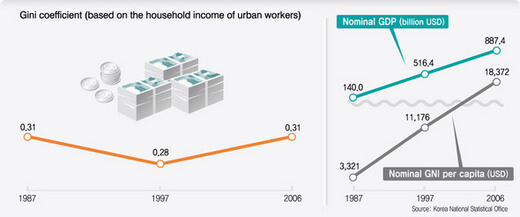
During the 20 years since democracy, South Korea's economy has seen an astronomical rise, with Gross Domestic Product (GDP) per annum jumping from US$140 billion to $887.4 billion, a sixfold increase. Individual income has increased fivefold over the same period. However, inequality in income distribution - specifically, the household income of an urban worker - has seen a series of fluctuations. This is measured using the Gini coefficient, a statistical measure of how 'equal' or 'unequal' a society's income distribution; the closer the coefficient is to 0.0, the more equal a country's income distribution; conversely, a score approaching 1.0 means near total inequality, with income concentrated in the top socioeconomic echelon of society. In 1987, South Korea's Gini coefficient was 0.31, which dropped to 0.28 by 1997, a sign that income had become more evenly distributed. This shows growth and distribution were achieved at the same time because of high economic growth and actual wage growth. However, 1997 was also the year that the Asian financial crisis dealt South Korea a crushing blow, and by 2006, the Gini coefficient had risen again to 0.31, back where it was in 1987. During the period between 1997 and 2006, Korea's economic size grew to around $800 billion from $500 billion, while distribution dropped.
Social welfare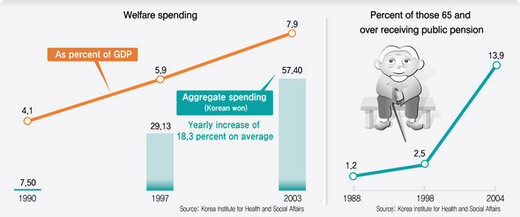
The nation's social welfare spending has grown 18.3 percent annually for the past 13 years, and the percentage of such spending out of GDP has increased about twofold. Nevertheless, Korea's social welfare spending as a GDP percentage is about half that of the U.S. and Japan, and about a third of the European average. The percentage of those receiving public pension among persons aged 65 or over has increased by a factor of 12 over the last 16 years to 13.9 percent in 2004. However, the corresponding figure is 60-70 percent on average in advanced European countries. Despite rapid growth in welfare spending since 1987, all types of indices show that Korea's welfare standard has a long way to go.
Education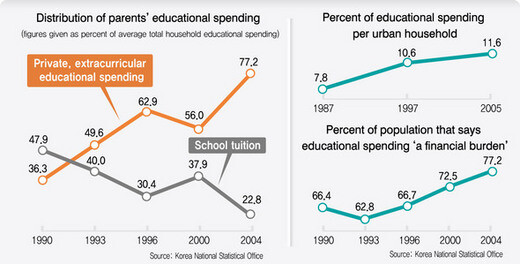
Most would contend that the educational sector has changed for the worse over the past two decades. The burden of private tutoring expenses for parents is growing daily, as students as young as elementary school age pack into after school cram academies until late at night in order to prepare for fierce competition with their peers for spots at top universities. This ever-growing competition means students' minimum human rights are being ignored. Neoliberal educational policies centering on competition, which have been pushed ahead with under the pretense of reform, have worsened the situation. One case in point is former president Kim Young-sam administration's May 31, 1995 reform plan, which was evaluated as an attempt to introduce more fierce competition to the national education system under the pretext of strengthening students' global competitiveness. The ideology of efficiency and competition gained greater momentum during the Kim Dae-jung and incumbent Roh Moo-hyun administrations, and is now affecting students even at the kindergarten and elementary school levels. In addition, as so called "special-purpose" magnet high schools have increased in number, with parents scrambling to get their children into what is rumored to be a sure ticket to a top university, the overall quality of education has declined, and university admissions thus depend more and more on parents' socioeconomic status. The 'polarization of education' is indeed intensifying.
However, positive changes have occurred, as well. Improvements have been made to educational conditions, such as the number of students per classroom. This figure used to be 60-70 students per room on average in the early 1980s, but had dropped to about 30 per classroom on average as of last year.
Human rights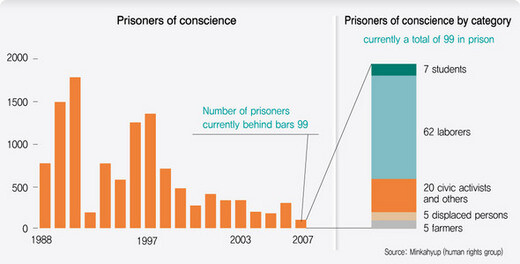
The number of prisoners of conscience in South Korea has been on the decline, a result not of reform of related laws and regulations, but by people's broadened awareness of the issue of human rights. The social atmosphere in South Korea is now such that judicial or police authorities cannot detain people at will, as they did in the past. Yet problems regarding draconian laws such as the National Security Law have not been fundamentally solved, so the nation still imposes punishment in cases where their legal action could be seen as a violation of basic human rights, such as freedom of speech or conscience, all of which are guaranteed by the Constitution. The application of the notorious National Security Law in several recent cases of policing content on the Internet is tantamount to punishing free thinking in 2007 via a law dating from 1948.
Labor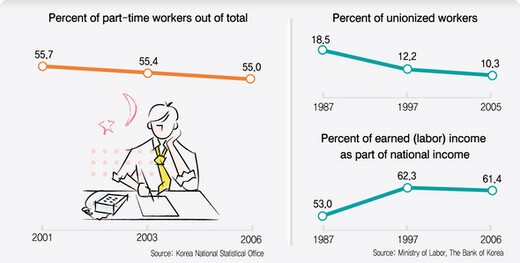
Union membership reached an apex in 1989 with 19.8 percent of all workers participating in some sort of labor organization, but has shown a downward trend since, recording around a 12-percent rate between 1997 to 2001 and 10.3 percent in 2005, the last figure a 48-percent drop from 1989's figures. As far as sheer population figures, the number of unionists decreased from 1.93 million in 1989 to 1.5 million in 2005, a 22.3-percent drop. The percentage of earned (labor) income out of total national income fell from 63.1 percent in 1996 to 58.2 percent in 2002 and then went back up to 61.4 percent in 2006, still below the figures recorded before the 1997-98 Asian financial crisis. The wage disparity of the lower 10 percent of earners versus upper 10 percent rose to a factor of 5.4 in 2006 from 4.8 in 2001, meaning that wages for the top decile of earners were nearly five-and-a-half times greater than those of the lowest decile of earners, a factor higher than that seen in the United States, whose wage disparity is the most serious among Organization of Economic Cooperation and Development (OECD) members. South Korea also held a dubious first place in terms of abuse and discrimination against part-time and short-term contract workers among OECD members. While the unemployment rate is comparably low and real wages have increased, the quality of employment and structure of income redistribution leave a great deal to be desired.
Journalism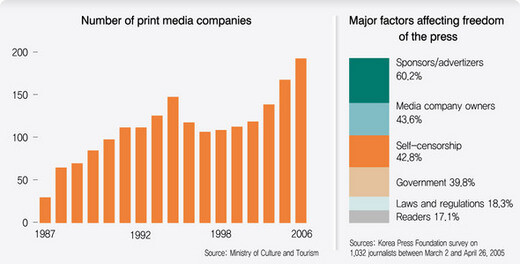
The number of newspapers and periodicals has increased by 6.5 times and 3.5 times, respectively, since 1987, a sign that freedom of speech has improved overall. However, while government influence on the media has diminished, advertisers and media owners have stepped in in its place. This is due to intensified competition stemming from the increasing number of media companies and the ever-strengthening influence of advertisers, such as business conglomerates, or
Please direct questions or comments to [englishhani@hani.co.kr]
Editorial・opinion
![[Correspondent’s column] The real reason the US is worried about Chinese ‘overcapacity’ [Correspondent’s column] The real reason the US is worried about Chinese ‘overcapacity’](https://flexible.img.hani.co.kr/flexible/normal/500/300/imgdb/original/2024/0510/5217153290112576.jpg) [Correspondent’s column] The real reason the US is worried about Chinese ‘overcapacity’
[Correspondent’s column] The real reason the US is worried about Chinese ‘overcapacity’![[Editorial] Yoon’s gesture at communication only highlights his reluctance to change [Editorial] Yoon’s gesture at communication only highlights his reluctance to change](https://flexible.img.hani.co.kr/flexible/normal/500/300/imgdb/original/2024/0510/7717153284590168.jpg) [Editorial] Yoon’s gesture at communication only highlights his reluctance to change
[Editorial] Yoon’s gesture at communication only highlights his reluctance to change- [Editorial] Perilous stakes of Trump’s rhetoric around US troop pullout from Korea
- [Guest essay] Preventing Korean Peninsula from becoming front line of new cold war
- [Column] The state is back — but is it in business?
- [Column] Life on our Trisolaris
- [Editorial] Penalties for airing allegations against Korea’s first lady endanger free press
- [Editorial] Yoon must halt procurement of SM-3 interceptor missiles
- [Guest essay] Maybe Korea’s rapid population decline is an opportunity, not a crisis
- [Column] Can Yoon steer diplomacy with Russia, China back on track?
Most viewed articles
- 1Korea likely to shave off 1 trillion won from Indonesia’s KF-21 contribution price tag
- 2Nuclear South Korea? The hidden implication of hints at US troop withdrawal
- 3[Editorial] Perilous stakes of Trump’s rhetoric around US troop pullout from Korea
- 4With Naver’s inside director at Line gone, buyout negotiations appear to be well underway
- 5In Yoon’s Korea, a government ‘of, by and for prosecutors,’ says civic group
- 6[Column] ‘Choson’: Is it time we start referring to N. Korea in its own terms?
- 7‘Free Palestine!’: Anti-war protest wave comes to Korean campuses
- 8How many more children like Hind Rajab must die by Israel’s hand?
- 9Overseeing ‘super-large’ rocket drill, Kim Jong-un calls for bolstered war deterrence
- 10[Photo] ‘End the genocide in Gaza’: Students in Korea join global anti-war protest wave